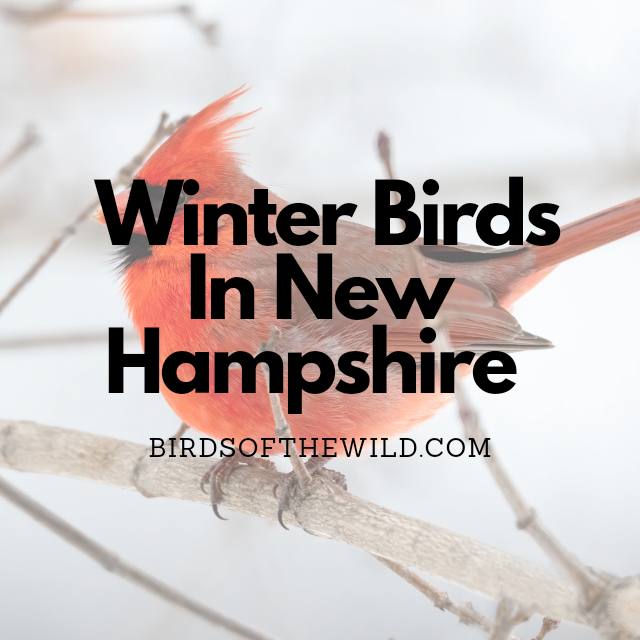In this article I’ll be going over 11 winter birds that can be found in the state of New Hampshire so continue reading to learn more about these birds below.
- Bald Eagle
- Golden Eagle
- Red Breasted Nuthatch
- Eastern Screech
- Black Capped Chickadee
- White Breasted Nuthatch
- Great Horned Owl
- Snowy Owl
- Northern Flicker
- Sharp Shinned Hawk
- Northern Cardinal
11 Winter Birds In New Hampshire
1. Bald Eagle (Haliaeetus Leucocephalus)

- Size: 90 – 108cm
- Weight: 3 – 6.3kg
- Wingspan: 180 – 250cm
Bald eagles are fall and winter non-breeding residents within southeast New Hampshire.
A bald eagle’s plumage consists of dark brown around its wing and body, with white feathers on its tail and head along with the trademark yellow beak and feet. Both male and female bald eagles look relatively the same.
As for where you can find these eagles, it will often be around lakes and reservoirs with lots of fish and surrounding forests. You’ll often find them around unfrozen lakes and hunting along coastlines, reservoirs, and rivers during the winter months
These eagles are birds of prey meaning they hunt other birds, medium sized mammals like rabbits, hares, other animals like reptiles, fish and even eat carrion when their options are limited. Sometimes bald eagles are recognised as fish eagles as their diet consists of fish and as meat is the only thing they eat these eagles would ultimately be regarded as carnivores too.
Bald eagles can live for around 20 years in the wild.
2. Golden Eagle (Aquila Chrysaetos)
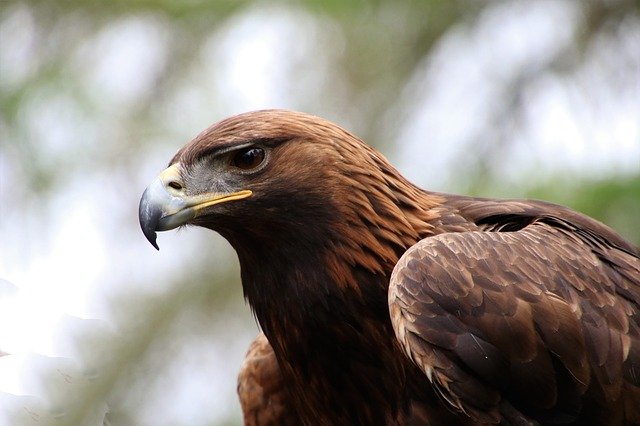
- Size: 70 – 82cm
- Weight: 3.7 – 5.3kg
- Wingspan: 190 – 212cm
Golden eagles can be found all across New Hampshire in the fall and winter months when they aren’t breeding.
These eagles are recognised by their mostly light brown and dark brown plumage, yellow feet and black downwards pointing beak. Females once again are the larger of the 2 birds where males are roughly 33% smaller in size.
These eagles spend the majority of their time within open moorlands and mountains within the likes of Scotland, and many areas within north America
Golden eagles do eat carrion but, it isn’t their first choice of food when hunting for prey. If they do find a dead carcass they will eat it, with their general food choices consisting of smaller mammals, birds and sometimes larger prey.
These eagles are known to live for around 14 years in the wild whilst captive are even able stay alive till their early 30’s with the longest observed at 32 years old.
3. Red Breasted Nuthatch (Sitta Canadensis)

- Size: 11 – 13cm
- Weight: 9 – 13 grams
- Wingspan: 18 – 22cm
Red breasted nuthatches can be found all across New Hampshire on a year round basis, including the winter months.
These Nuthatches have rusty orange colored breast feathers, gray wings and back, with a vertical black and white striped pattern on their head. Females are very similar in color scheme but, their plumage does look duller and more washed out.
You can find a red breasted nuthatch around coniferous forests of spruce, fir, pine, hemlock, larch, and western red cedar.
As for what they eat, it includes insects and seeds where they mostly eat spiders in the summer whilst around winter they chow down on a variety of different seeds, especially seeds in conifers.
The lifespan of red breasted nuthatch is around 6 years on average.
4. Eastern Screech Owl (Megascops Asio)

- Size: 16 – 25cm
- Weight: 121 – 244 grams
- Wingspan: 49 – 61cm
You’ll be able to spot eastern screech owls in the majority of New Hampshire on a year round basis which would include the winter.
Eastern screech owls are recognised by their mostly gray plumage. Females are generally larger and have a feathers that are brown in color.
These owls can be found around open mixed woodlands, deciduous forests, parklands, wooded suburban areas, riparian woods along streams and wetlands.
Eastern screech owls eat a variety of foods from small animals, including birds and mammals as well as earthworms, insects, crayfish, tadpoles, frogs, and lizards.
As for how long these owls are known to live for, it’s typically around the 14 year mark in the wild.
5. Black Capped Chickadee (Poecile Atricapillus)

- Size: 10 – 15cm
- Weight: 10 – 12 grams
- Wingspan: 15 – 20cm
You can spot black capped chickadee year round in New Hampshire as it’s one of their many permanent residencies in America. This also means they can be found in the state throughout winter.
Black capped chickadees are recognised by their mostly white plumage from breast to tail with gray wings, black throat and upper head. Females look very much the same as their male counterparts.
Your typical chickadee will spend their time within open woods and forest edge, especially where birches or alders grow. They also avoid coniferous forests.
As for what they eat, it mostly consists of insects, fruits, seeds among other berries. The diet does change based on the weather. A large portion of a chickadees diet consists of insects in the summer whilst in winter it tends to be a seed, fruit and vegetable based diet that makes up around 50% of what they eat.
Black capped chickadees are known to live for around 2 – 3 years in the wild although, the longest recorded lifespan is said to be around 11.5 years.
6. White Breasted Nuthatch (Sitta Carolinensis)
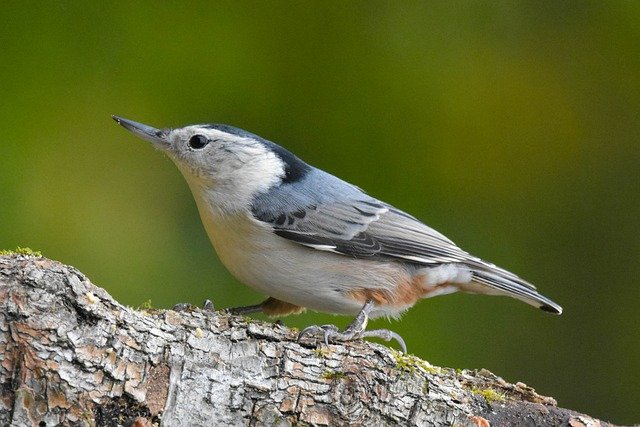
- Size: 13 – 14cm
- Weight: 18 – 30 grams
- Wingspan: 20 – 27cm
White breasted nuthatches can be found in all of New Hampshire on a year round basis, including the winter months.
These white breasted nuthatches are recognised by their gray back, wings and the upper head with white breast feathers. Females look the same as the males.
As for where you would find these white breasted nuthatches, it would be around mature woods and woodland edges, where they’re most commonly located by deciduous stands that have maple, hickory, basswood, oak and are even found in some coniferous forests.
They mostly consume nuts, seeds and insects, which can include hazelnuts, sunflower seeds and suet.
As for how long white breasted nuthatches live in the wild, it tends to be around 2 years with the longest lifespan recorded around 12 years.
7. Great Horned Owl (Bubo Vrginianus)

- Size: 57 – 63cm
- Weight: 1.4 – 1.5kg
- Wingspan: 1.35 – 1.5m
Great horned owls can be found all across New Hampshire year round including the winter months.
These large horned owls are recognised by their brown/gray plumage with their defining feature being the tuft of feather on the top of their head resembling a horn or ear like feature. Male and female great horned owls look relatively the same with the females slightly larger in size.
At night these birds will perch on a branch or a tall building to look around for prey and once the desired prey has been found they will fly towards it with folded wings, grab the prey with their talons piercing through their body and in most cases killing them immediately.
As for what these birds eat it includes smaller prey like rodents, frogs or scorpions. Even other larger predators like geese, ducks, hawks, and smaller owls can be eaten by these carnivorous birds.
Great horned owls are most commonly found in deserts, wetlands, forests, grasslands, backyards, cities and they can also be found in semi-open habitats between the Arctic and the tropics.
As for a great horned owls lifespan, it can be anywhere from 15 -25 years.
8. Snowy Owl (Bubo Scandiacus)
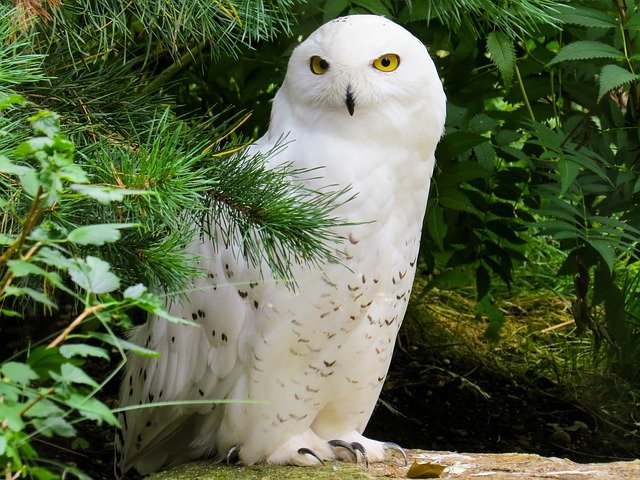
- Size: 52 – 71cm
- Weight: 1.1 – 2kg
- Wingspan: 125 – 164cm
Snowy owls can be found in New Hampshire when they aren’t breeding. This typically will encompass the fall and winter months.
These owls are recognised by their mostly white plumage with brown dots throughout the body. Females on the other hand are generally less white than the males as the brown spots encompass more of their body.
Snowy owls tend to spend their time within arctic tundra or open grasslands and fields, whilst avoiding forested areas.
As for what they eat, it includes lemmings and a variety of small mammals. Nevertheless, they will still occasionally eat larger mammals like like hares, rats, rabbits, etc.
Snowy owls have been observed to live for around 28 years in captivity and between 10+ years in the wild.
9. Northern Flicker (Colaptes Auratus)

- Size: 30 – 35cm
- Weight: 115 – 125 grams
- Wingspan: 50 – 55cm
These northern flickers can be found all across New Hampshire year round, which inlcudes the winter months.
Northern flickers are recognised by their mostly cream colored body with black spots, orange and black tail feathers and elements of red on the lower part of their face. Females look very similar to the males minus the red elements on their face.
You’ll often find northern flickers around woodlands, forest edges, and open fields with scattered trees, as well as city parks and suburbs.
As for what they tend to eat, it includes mostly insects along with smaller fruits and berries.
Northern flickers are known to live for around 5 – 7 years on average with the longest recorded to be 9 years and 2 months.
10. Sharp Shinned Hawk (Accipiter Stratus)

- Size: 23 – 37cm
- Weight: 82 – 220 grams
- Wingspan: 42 – 68cm
Sharp shinned hawks are year round residents across the majority of New Hampshire, which includes the winter months.
These hawks are recognised by their gray wings and back, brown and white breast and belly with a pair of yellow feet. Females look very similar to the males but are roughly a third larger.
Sharp shinned hawks can be found around mixed or coniferous forests, open deciduous woodlands, thickets, edges
These hawks will often eat birds from the size of a sparrow up to that of a robin’s size and in rare occasions some birds that are the size of quails too. They also eat the occasional rodent, bats, squirrels, lizards, frogs, snakes, and large insects.
Sharp shinned hawks will typically live for around 5 – 6 years on average, although some are able to live 10+ years in the right environment.
11. Northern Cardinal (Cardinalis Cardinalis)
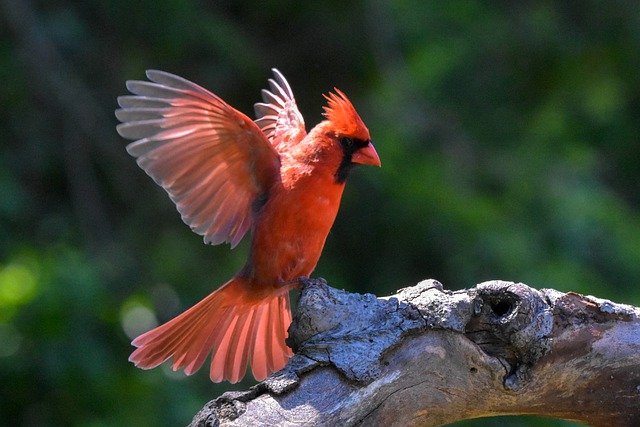
- Size: 21 – 23cm
- Weight: 42 – 48 grams
- Wingspan: 30 – 35cm
You’ll find northern cardinals in all of New Hampshire on a year round basis, which includes the winter months.
Northern cardinals are recognised by their mohawk-like head feathers, red exterior and beak with elements of black across the face. Females also have elements of red on their beaks and their body but, in smaller amounts, with the majority of their plumage a light brown color.
These cardinals can be found in woodlands, gardens, shrublands, wetlands and backyards if the sugar water or seeds in the feeders satisfy their taste buds.
As for the food they eat, it consists of small insects like beetles, true bugs, grasshoppers, caterpillars, ants, flies, spiders, centipedes, and snails. Seeds of weeds, berries among other smaller fruits are part of their diet too.
Northern cardinals are known to live for around 15 years in the wild although the actual number probably a lot less.
Amhil Khan, a dedicated nature enthusiast and the founder of BirdsOfTheWild.com, is a passionate advocate for the captivating world of avian wonders. With a deep-seated curiosity about the intricate lives of birds, Amhil’s journey began as a fascination and has evolved into a mission to inspire others to appreciate and protect these magnificent creatures.
Amhil’s love for birds led to the creation of Birds of the Wild, a platform where his expertise in ornithology, coupled with his captivating storytelling, provides readers with an immersive and educational experience. Through his lens and words, he captures the essence of birds in their natural habitats, offering a glimpse into their behaviors, migrations, and the ecosystems they inhabit.

